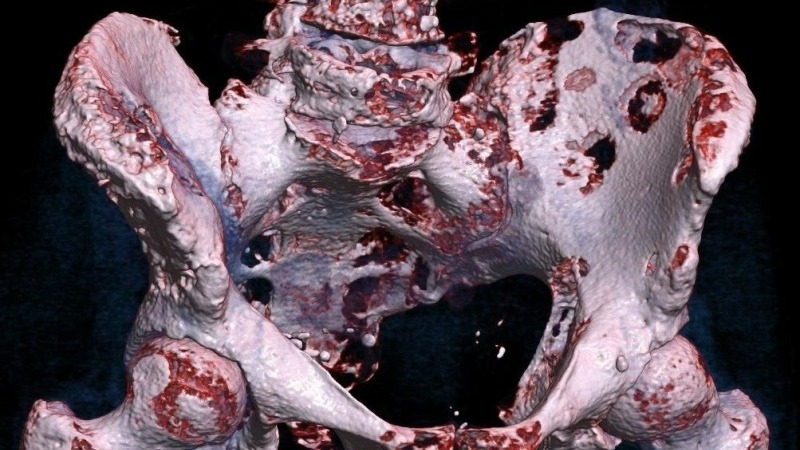What’s on the horizon for treating bone metastases?
MDlinx Dec 21, 2022
Bone and bone marrow are the most common sites of cancer metastases, which predict poor patient outcomes. Consequently, the prevention and treatment of bone metastases is a top priority for specialists.

Treatment of bone metastases is limited in efficacy and linked to increased comorbidity.
Improved understanding of the underlying molecular pathways of bone metastasis could lead to novel treatments that are well-tolerated and more effective, as suggested by the authors of a review published in Cells.
Ban J, Fock V, Aryee DNT, et al. Mechanisms, diagnosis and treatment of bone metastases. Cells. 2021;10(11):2944.
Understanding bone metastases
The development of solid-tumor metastases is complex, with the spread of tumor cells facilitated by pre-metastatic niche formation, tumor cell dissemination via circulation, and chemotactic attraction/homing of tumor cells to the metastatic site or organ.
Reciprocal interactions between local stromal cells and immune cells also play a role.
The problem with available treatments
The two main challenges of bone tumor therapy are repairing large bone defects and clearing any remaining tumors.
Overall, the treatment of bone tumors is limited by conventional means, and these strategies need to be replaced or used in tandem, according to a review published in Cancers.
Bădilă AE, Rădulescu DM, Niculescu AG, et al. Recent advances in the treatment of bone metastases and primary bone tumors: An up-to-date review. Cancers (Basel). 2021;13(16):4229.
Here's a look at some emerging treatments for bone metastases.
Adjuvant therapies
Following the use of a curette, adjuvant therapies can help decrease bone cancer recurrence and eliminate the need for major resection and reconstruction. One example is radiofrequency ablation, the best-understood thermoablative technique. It is reliable, minimally invasive, safe, and effective at controlling bone tumors and reducing pain.
Radiofrequency affects solid tumors via frictional heating that’s produced when ions in the target tissue try to follow the changing polarities of a high-frequency alternating current.
The Joule effect destroys any neighboring tissue, and the resulting dehydration mediates higher tissue resistance during ablation. These effects restrict energy application and mitigate the expansion of the ablation area. Tumors larger than 3 cm, however, should be carefully managed as tumors. Previous radiation therapy also may predict complications.
Other ablative technologies that could be effective in treating bone metastases include microwave ablation, laser ablation, and high-intensity focused ultrasound (HIFU)—a technology that uses ultrasound energy and thermal feedback. With HIFU, when the ultrasound beam is focused on the lesion, the heat generated leads to coagulative necrosis/cell death, according to the Cancers research.
It should be pointed out that none of these therapies are considered the standard of care for most patients, and as of this writing there are no outcome benefits published for any of these modalities. However, selected patients (symptomatic, focal disease) may benefit from them, according to a literature review published by UpToDate.
Kurup AN, Callstrom MR. Image-guided ablation of skeletal metastases. UpToDate. Updated April 28, 2021.
Immunotherapy
Various biologics have been assessed in an attempt to treat bone metastases, including chimeric antigen receptor T-cell therapy; depletion of Tregs with anti-CD25 antibody (eg, daclizumab and basiliximab) with or without cyclophosphamide; fludarabine and paclitaxel-based chemotherapy; and antibodies versus immunosuppressive CTLA-4 (eg, ipilimumab and tremelimumab).
According to the authors of the review published in Cells, “Recently, the concept of osteoimmuno-oncology has been introduced, which takes into account the interactions between tumor, immune and bone cells in the bone microenvironment and may thus provide the basis for the development of more effective immunotherapies against bone metastasis in the future.”
In-progress trials involving immunomodulators and bone metastases include an open-label, multi-center, phase 1/2 study involving the use of radium-223 dichloride and pembrolizumab in patients with stage IV non-small cell lung cancer with bone metastases.
Eligible patients are either treatment-naïve for advanced disease or have progressed on immunologic checkpoint blockade. The researchers aim to measure tumor shrinkage due to treatment and the duration of shrinkage, as well as safety.
Pembrolizumab is an immunologic checkpoint blocker that mediates an immune response against tumors, and radium-223 dichloride is an alpha-particle-emitting radioactive agent that kills cancer, as reported in studies listed on ClinicalTrials.gov.
Study to test the safety and how radium-223 dichloride an alpha particle-emitting radioactive agent works in combination with pembrolizumab an immune checkpoint inhibitor in patients with stage IV non-small cell lung cancer with bone metastases. Clinicaltrials.gov. Updated November 8, 2022.
Drug delivery and carrier systems
Novel systems of delivery could help enhance chemotherapy outcomes and circumvent the need for small systemic dosing or large local doses of conventional chemotherapies.
Examples include nanocarrier systems that deliver drug payloads directly to targeted bone-tumor sites and protect these drugs from clearance, as well as extending circulation times, enhancing therapeutic efficacy, and decreasing the incidence of adverse effects.
Such technology has already been investigated to enhance bone healing. To surmount the limitations of systemic administration of drugs, micro-sized and nanosized vehicles have been built to deliver drugs to bone in a targeted fashion.
These carrier systems will need to be biocompatible and inert to bone healing, according to the Cancers review. Examples include polymeric nanoformulations, lipid nanoparticles, carbon-based nanoparticles, and inorganic nanoparticles.
What this means for you
Bone metastases are a dreaded complication of cancer that typically have a poor prognosis for patients who develop them. Available treatments leave much to be desired, but there are exciting inroads being made into the treatment of bone metastases.
-
Exclusive Write-ups & Webinars by KOLs
-
Daily Quiz by specialty
-
Paid Market Research Surveys
-
Case discussions, News & Journals' summaries